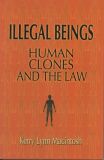用户登陆搜 索 |
查看图书
图书目录:Acknowledgments
Introduction PART ONE: FIVE COMMON OBJECTIONS TO HUMAN REPRODUCTIVE CLONING REFLECT, REINFORCE, AND INSPIRE STEREOTYPES ABOUT HUMAN CLONES 1 Does Human Reproductive Cloning Offend God and Nature? 1. God 2. Nature 3. Cloning and Frankenstein 2 Should Children Be Begotten and Not Made? 1. Lessons from Assisted Reproductive Technologies 2. Stereotypes 3 Do Human Clones Lack Individuality? 1. Why Is the Identity Fallacy Wrong? 2. Can Hitler Be Reborn? 3. Individuality and Autonomy 4. Family Relationships 5. Identity Theft 6. Stereotypes 4 Could Human Clones Destroy Humanity? l. Overpopulation 2, Genetic Diversity 3. Eugenics and Genetic Engineering 5 Does Human Reproductive Cloning Harm Participants and Produce Children with Birth Defects? 1. The Efficiency of Cloning a) Dolly and the 277 "Attempts" b) Current Success Rates c) Efficiency in the Future 2. The Role of Large Offspring Syndrome 3. The Role of Reprogramming 4, The Telomere Scare 5. Stereotypes a) Inefficiency b) Large Offspring Syndrome c) Reprogramming d) Telomeres 6. The Dangers of Excessive Caution Summary of Part One PART TWO: ANTICLONING LAWS ARE BAD PUBLIC POLICY 6 What Anticloning Laws Say and Do 1. Federal Bills a) Efforts to Ban All Cloning b) Efforts to Ban Reproductive Cloning Only c) The Commerce Clause 2, FDA 3. State Laws 4, Possible Legal Futures 7 The Five Objections Have Inspired Anticloning Laws 1. Federal Law a) Cloning Offends God and Nature b) Cloning Treats Humans as Products c) Human Clones Are Copies d) Human Clones Could Destroy Humanity e) Cloning Is Unsafe 2. State Law 8 Anticloning Laws Reflect a Policy of Existential Segregation 1. Antimiscegenation Laws 2. Anticioning Laws in Historical Context 9 The Costs of Anticloning Laws Outweigh Their Benefits... 1. The Costs of a National Ban on Cloning a) First Cost: Violation of Procreative Freedom b) Second Cost: Violation of Scientific Freedom c) Third Cost: Loss of Human Resources d) Fourth Cost: Exclusion of Citizens at the National Border e) Fifth Cost: Legal Stigma f) Sixth Cost: Loss of Parents, Funds, and Assets g) Seventh Cost: Loss of Medical and Personal History h) Eighth Cost: The High Cost of Living a Lie i) Ninth Cost: Isolation j) Tenth Cost: Undermining Egalitarianism 2. The Costs of State Anticloning Laws 3. The Benefits of Anticloning Laws a) Keeping God and Nature Happy b) Ensuring that Humans Are Not Treated as Products c) Preventing the Birth of Copies d) Saving Humanity e) Safety i) Protecting Participants from Harm ii) Preventing the Birth of Children with Physical Defects Summary of Part Two PART THREE: ANTICLONING LAWS VIOLATE THE EQUAL PROTECTION GUARANTEE AND ARE UNCONSTITUTIONAL 10 Anticloning Laws Classify Human Clones and Are Subject to Strict Scrutiny 1. Anticloning Laws Deliberately Treat Human Clones Differently from Humans Born through Sexual Reproduction a) Disparate Impact b) Discriminatow Purpose 2. Strict Scrutiny Applies Because Human Clones Are a Suspect Class a) Disabilities, History, and Powerlessness: The Need for Extraordinary Judicial Protection b) Discrete and Insular Minorities c) Visible Characteristics d) Immutable Characteristics e) Fairness, Stereotypes, and the Ability to Contribute to Society f) Stigma and Opprobrium g) Congressional Action and Political Realism 3. Summary 11 Anticloning Laws Inflict Judicially Cognizable Injuries that Confer Standing 1. Basic Principles of Federal Standing 2. First Example: Exclusion at the National Border 3. Second Example: Prosecution of Parents 4. The Need for a New Approach to Standing 5. Third Example: Targeting and Legal Stigma 6. Plaintiffs May Find It Easier to Establish Standing to Challenge Anticloning Laws in State Courts 7. Summary 12 Anticloning Laws Violate the Equal Protection Guarantee 1. The Government Cannot Prove that Cloning Offends God and Nature; Moreover, Religious and Moral Objections Are Not Considered Compelling Interests 2. The Government Cannot Prove that Cloning Treats Humans as Products; Moreover, Anticloning Laws Are Not Narrowly Tailored to Protect Human Dignity 3. The Government Cannot Prove that Human Clones Are Copies; Moreover, Anticloning Laws Are Not Narrowly Tailored to Protect Individuality 4. The Government Cannot Prove Human Clones Threaten the Survival of Humanity; Moreover, Anticloning Laws Are Not Narrowly Tailored to Protect Humanity 5. The Government Cannot Prove that Cloning Is Unsafe or that Human Clones Are Physically Flawed; Moreover, Anticloning Laws Are Not Narrowly Tailored to Meet Safety Concerns Today and in the Future a) Protecting Participants from Harm b) Preventing the Birth of Humans with Physical Defects c) The Legacy of Buck v. Bell d) Proving the Superiority of Nonexistence e) Safety in the Future f) Narrowly Tailored Means 6. Summary Conclusion Notes Index |

